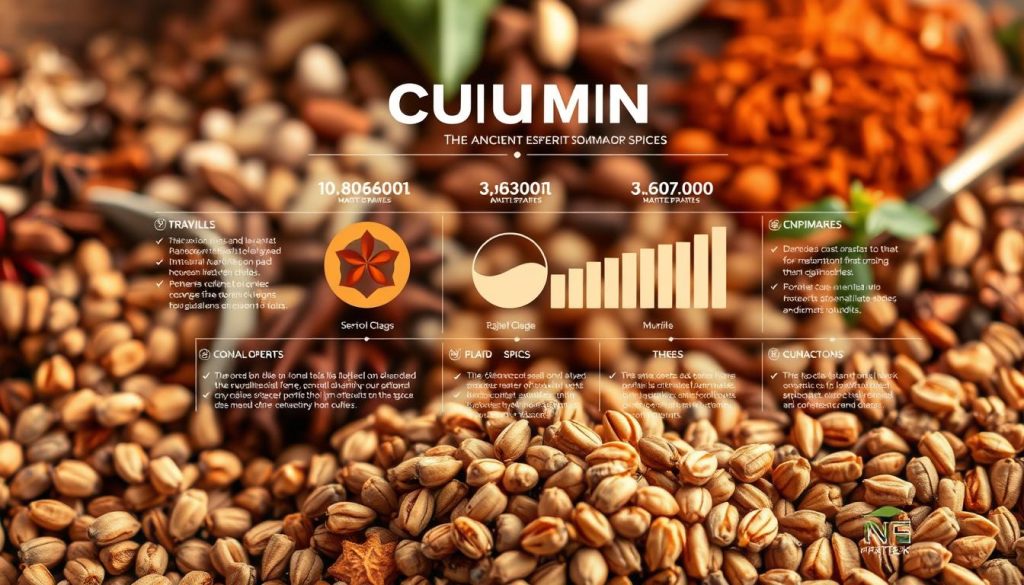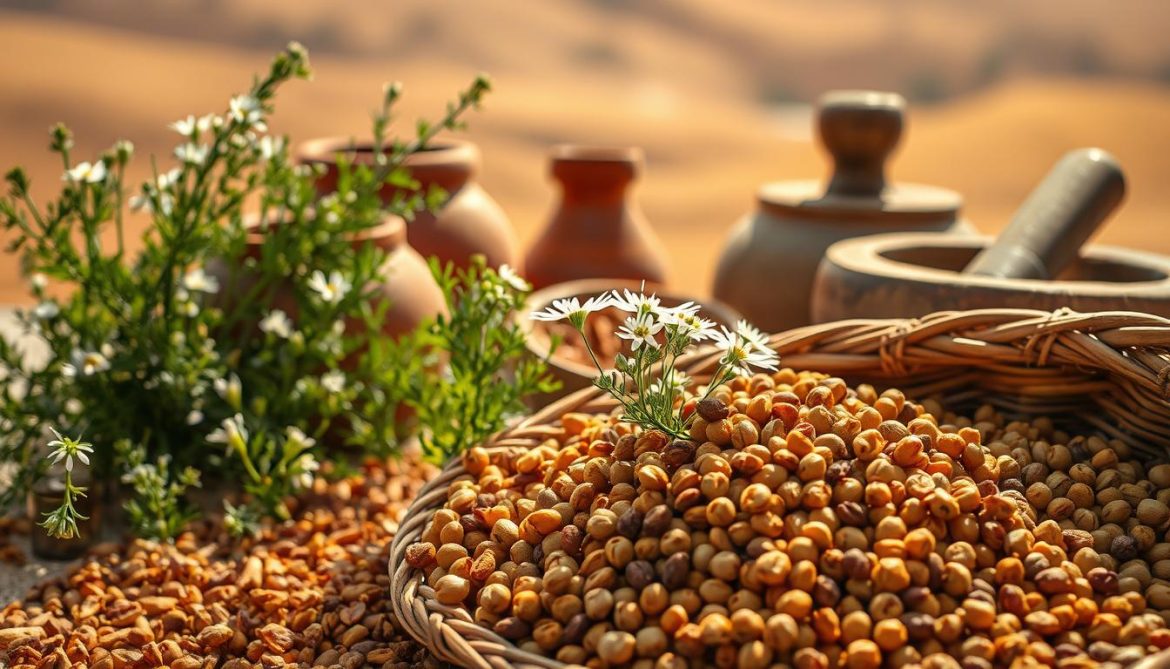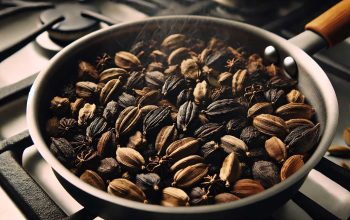Hey spice adventurers! 👋 Get ready to explore the amazing journey of cumin. This spice has traveled through centuries and continents. It carries stories of ancient civilizations, trade routes, and culinary magic that will amaze you! 🌿✨
Cumin is more than just a spice in your kitchen. It’s a historical treasure filled with flavor and tradition. From Mediterranean kitchens to global cuisine, it has been changing dishes and connecting cultures for thousands of years.
Imagine walking through sun-drenched fields where cumin plants sway gently. Their seeds hold secrets of generations of farmers and cooks. Each seed tells a story of survival, adaptation, and incredible taste that has captivated food lovers worldwide.
As we explore cumin, you’ll see how this humble spice became a global culinary superstar. We’ll uncover its roots, explore its incredible journey, and celebrate the magic that makes cumin essential in kitchens. Are you ready for a flavor-packed adventure? Let’s go! 🌶️🌍
Ancient Origins: Tracing Cumin’s Historical Roots
Explore the world of cumin seeds, a spice that has amazed people for thousands of years. My journey through time shows how this ingredient has flavored dishes and influenced cultures in the ancient world.
The Mediterranean Basin was where cumin first grew. Early farmers saw the great value of these small seeds. Archaeological finds show how important cumin was to ancient societies.
Early Cultivation Techniques
Farmers in the Mediterranean learned how to grow cumin seeds well. They knew these seeds were more than just a flavor enhancer. They were used for:
- Medicinal treatments
- Culinary innovations
- Preservation techniques
- Religious and cultural rituals
Archaeological Discoveries
“Cumin powder was more than a spice – it was a treasure of ancient civilizations” – Archaeological Historian
Excavations in Egypt, Mesopotamia, and the Mediterranean uncovered cumin’s importance. Researchers found cumin seeds in ancient sites. This showed its use in cooking, medicine, and trade.
Cultural Significance
Ancient cultures valued cumin seeds for their many uses. From Egyptian pharaohs to Mediterranean traders, cumin powder was more than food. It stood for wealth, health, and cultural exchange.
Picture walking through an ancient market. Merchants traded cumin seeds like gold, filling the air with their scent and promise.
Understanding the Cumin Plant Anatomy
Let’s explore the amazing world of cumin, a herb from the Apiaceae family. This herb is both delicate and strong, growing up to 30-50 centimeters tall. Its slender, branched structure fascinates many.
The cumin plant’s anatomy is truly fascinating. Its leaves are fine and feathery, divided deeply. This creates a beautiful green network that looks like lace. Whole cumin seeds come from small white or pink flowers in clusters, typical of the parsley family.
- Root system: Shallow and fibrous
- Stem: Slender and branched
- Leaves: Finely dissected and feather-like
- Flowers: Small, white or pale pink clusters
The seeds of cumin are its greatest treasure. These tiny, boat-shaped seeds are brown or yellowish-brown. They are full of essential oils that give cumin its unique warm, earthy smell.
“The cumin seed is nature’s flavor capsule, holding centuries of culinary tradition in its compact form.” – Spice Historians
| Plant Characteristic | Description |
|---|---|
| Height | 30-50 centimeters |
| Growing Season | Annual herb |
| Seed Color | Brown to yellowish-brown |
| Seed Shape | Boat-shaped, elongated |
Understanding cumin’s anatomy shows us the beauty of nature’s culinary art. From its delicate leaves to its flavorful seeds, cumin is a true marvel.
The Global Journey of Cumin Seeds Through Trade Routes
Imagine a spice that has traveled thousands of miles. It crossed continents and cultures, carrying a rich history. Cumin seeds have been more than just a food item. They’ve been global ambassadors of flavor and trade for centuries.
Silk Road: The Ancient Spice Highway
The legendary Silk Road was more than a trading route. It was a lifeline for cumin spice. Caravans traveled through tough terrains, carrying precious cumin seeds across:
- Persia (modern-day Iran)
- Central Asian steppes
- Chinese imperial territories
Maritime Spice Trading: Oceans of Opportunity
As maritime trade grew, cumin seeds found new paths across oceans. European merchants and Arab traders were key in spreading this aromatic treasure.
| Trade Route | Key Regions | Impact on Cumin Distribution |
|---|---|---|
| Indian Ocean Trade | India, Arabia, East Africa | Expanded cumin’s culinary influence |
| Mediterranean Routes | Italy, Greece, Turkey | Introduced cumin to European cuisines |
Modern Distribution Networks
Today, cumin seeds travel faster and more efficiently. Global supply chains connect farmers in India, Iran, and Turkey with kitchens worldwide. This ensures the spice reaches food lovers everywhere.
“Cumin seeds are not just a spice, but a testament to human connection and culinary exploration.” – Spice Historians
Cultivation Requirements for Premium Cumin Growth
Growing top-notch cumin is more than just throwing seeds in the ground. It’s about knowing exactly what these plants need to thrive. They require specific conditions to grow well and develop their unique flavor.
Here are the main things needed for growing premium cumin:
- Soil Conditions: Cumin likes well-drained, rich soil with a pH of 6.0 to 7.0. Sandy loam is the best soil for it.
- Climate Preferences: These plants prefer warm, sunny spots with temperatures between 68°F and 85°F.
- Sunlight Exposure: They need full sun to grow strong and produce lots of seeds.
Watering is also key in growing cumin. They need steady moisture but not too much. Using drip irrigation or careful hand watering helps keep them healthy.
“The secret to exceptional cumin lies in understanding its delicate nature and providing exactly what it needs to flourish.” – Spice Cultivation Expert
Farmers should watch how they space and plant the seeds. Plant them about 1/4 inch deep, with 8 inches between each plant. This ensures they get enough air and nutrients.
- Ideal planting season: Early spring
- Germination time: 7-14 days
- Harvest period: About 120 days after planting
By learning these growing tips, farmers can make cumin seeds that are full of flavor. This makes the spice stand out in taste and smell.
Traditional Harvesting Methods of Cumin
Cumin seeds are a delicate treasure that needs careful handling. The harvesting process is a dance of timing, skill, and tradition. It’s passed down through generations of farmers.
Manual Harvesting Techniques
Farmers handle cumin seed collection with great care. The traditional method involves several steps:
- Identifying the perfect ripeness of cumin plants
- Hand-cutting the stems near the base
- Carefully bundling harvested plants
- Drying plants in controlled environments
Post-Harvest Processing
After harvesting, cumin seeds start their transformation. Farmers separate the seeds from dried plant material through threshing. This method keeps the cumin aroma strong.
| Processing Stage | Description | Duration |
|---|---|---|
| Drying | Spread plants under direct sunlight | 3-5 days |
| Threshing | Separate seeds from plant material | 1-2 hours |
| Cleaning | Remove debris and impurities | 30-45 minutes |
Quality Control Measures
Ensuring top-quality cumin seeds is crucial. Farmers and processors check color, aroma, and moisture. This ensures premium spice production.
“Every cumin seed tells a story of tradition, care, and agricultural expertise.” – Spice Cultivation Expert
The journey from field to spice jar is filled with passion and skill. It’s a blend of generations of wisdom. Each cumin seed has the power to make dishes special.
Modern Production: From Field to Market
The journey of cumin from fields to your kitchen is amazing. It mixes old farming ways with new tech. Ground cumin powder doesn’t just appear out of thin air. It’s made through detailed steps that turn cumin seeds into a valuable spice.
Modern cumin making has several key steps:
- Precision farming techniques
- Advanced harvesting methods
- Automated processing systems
- Rigorous quality control
Farmers use advanced tools to grow and pick cumin. They use satellite images and GPS to keep an eye on the crops. This ensures the cumin grows well, making high-quality powder.
| Production Stage | Key Technologies | Impact on Quality |
|---|---|---|
| Cultivation | Precision Agriculture | Enhanced Crop Yield |
| Harvesting | Mechanical Harvesters | Reduced Seed Damage |
| Processing | Industrial Milling | Consistent Ground Cumin |
The milling step turns whole cumin seeds into fine powder. Temperature-controlled environments keep the spice’s oils and flavor safe.
“Every pinch of ground cumin represents centuries of agricultural innovation and culinary tradition.”
Quality teams check each cumin batch carefully. They make sure it meets strict food safety rules. From eco-friendly farming to advanced processing, modern cumin making shows top-notch farming skills.
Distinguishing Features of High-Quality Cumin Seeds
Exploring the unique traits of premium cumin seeds can change how you cook. Let’s explore these aromatic wonders. Learn how to spot the best cumin seeds to make your meals better.
Physical Characteristics of Premium Cumin Seeds
Several visual signs can show if cumin seeds are of high quality:
- Color: Look for a warm, rich brown with slight variations in tone
- Shape: Boat-shaped seeds with distinctive longitudinal ridges
- Texture: Smooth surface with a slightly oily appearance
- Size: Uniformly sized seeds indicating careful selection
Exploring Cumin Flavor Profiles
The magic of cumin seeds is in their complex aroma and flavor. Premium cumin takes you on a sensory journey:
| Flavor Aspect | Characteristic |
|---|---|
| Initial Aroma | Warm, earthy with nutty undertones |
| Taste Profile | Slightly bitter, pungent with warm spiciness |
| Aftertaste | Lingering warmth with subtle smokiness |
“A true cumin seed tells a story of earth, warmth, and culinary passion with every single grain.” – Spice Experts
When picking cumin seeds, trust your senses. High-quality cumin seeds have a strong, vibrant aroma. This aroma hints at the rich flavor they bring to your cooking. The flavor should be bold yet balanced, making simple dishes into culinary masterpieces.
The Science Behind Cumin’s Distinctive Flavor
Explore the amazing world of cumin flavor, where chemistry and cooking come together! The unique cumin aroma is not just random. It’s a beautiful mix of molecular interactions.

At the core of cumin’s taste are several important compounds. These compounds make up its unique flavor:
- Cuminaldehyde: The main compound that gives cumin its special taste
- Beta-pinene: Adds herbal notes to the flavor
- Gamma-terpinene: Brings depth to the cumin aroma
“Flavor is a dance of molecules, and cumin leads with precision!” – Culinary Science Experts
The complex chemistry of cumin makes it more than just a taste. Our sense of smell plays a big part in enjoying its flavor. It turns every bite into a rich, layered experience.
| Compound | Flavor Contribution | Percentage |
|---|---|---|
| Cuminaldehyde | Primary Flavor Essence | 45-50% |
| Beta-pinene | Herbal Notes | 15-20% |
| Gamma-terpinene | Aromatic Complexity | 10-15% |
Learning about cumin’s flavor science shows why it’s loved worldwide. Each molecule works together. They create a taste that’s warm, earthy, and slightly nutty.
Essential Oil Components in Cumin
Explore the amazing world of cumin’s essential oils. Here, nature’s healing meets culinary magic. These tiny seeds are packed with bioactive compounds. They turn cumin into a wellness powerhouse.
Chemical Composition Breakdown
Cumin’s essential oils are a mix of remarkable chemical compounds. Let’s look at the key components that make cumin a nutritional superstar:
- Cuminaldehyde: The primary active compound
- Limonene: A potent antioxidant
- P-cymene: Contributing to therapeutic properties
- Terpenoids: Supporting overall health benefits
Therapeutic Properties Unveiled
Cumin’s health benefits go beyond cooking. Scientific research shows its remarkable therapeutic potential:
| Property | Potential Health Impact |
|---|---|
| Antimicrobial | Fights harmful microorganisms |
| Anti-inflammatory | Reduces body inflammation |
| Antioxidant | Protects cells from damage |
“Cumin is not just a spice, it’s a natural pharmacy in a seed!” – Wellness Experts
Researchers keep finding new uses for cumin. Its essential oils show promise in digestive health, immune support, and metabolic wellness.
Next time you add cumin to your dish, remember. You’re not just adding flavor. You’re bringing in a natural healing powerhouse!
Traditional Uses of Cumin in Global Cuisines
Explore the world of cumin spice, a treasure that has changed flavors across the globe! This aromatic gem turns simple dishes into amazing culinary experiences. It adds magic to many global cuisines.
See how cultures around the world use cumin with passion and creativity:
- Mexican Cuisine: Cumin is key in chili con carne and taco seasonings
- Indian Cooking: It’s a must in garam masala and curry blends
- Middle Eastern Dishes: It’s a big part of spice mixes like za’atar and baharat
- North African Tagines: It adds deep, warming flavor to slow-cooked stews
“Cumin doesn’t just add flavor – it tells a story of cultural connection through food!” – Spice Enthusiast
| Region | Typical Cumin Dishes | Flavor Profile |
|---|---|---|
| Mexico | Chili, Enchiladas | Earthy, Warm |
| India | Curry, Biryani | Complex, Aromatic |
| Middle East | Falafel, Hummus | Nutty, Robust |
Whether you cook at home or love exploring new flavors, cumin is a great adventure. Every sprinkle brings a story of tradition to your kitchen!
Processing Methods: Ground Cumin vs. Whole Seeds
Spice lovers know cumin comes in two forms: whole seeds and ground cumin. Each method changes how you enjoy this amazing spice.
Whole cumin seeds are packed with flavor. They keep oils and scents that make food amazing. Toasting them brings out a deep, nutty taste.
Grinding Techniques for Cumin
Ground cumin is easy to use and adds flavor fast. Here are some ways to grind it:
- Traditional mortar and pestle for small batches
- Electric spice grinders for quick, uniform results
- Commercial industrial grinding machines
Storage Recommendations
Keeping spices fresh is key. Here’s how to store whole and ground cumin:
- Store in airtight containers
- Keep away from direct sunlight
- Maintain cool, dry environments
- Use ground cumin within 6 months
- Whole cumin seeds can last up to one year
“The secret to exceptional flavor is understanding how to process and store your spices!” – Culinary Experts
Pro tip: Fresh ground cumin tastes better than pre-ground. Grind your whole cumin seeds just before cooking for the best flavor!
Nutritional Profile and Health Benefits

Cumin is more than a spice in your kitchen. It’s a nutritional powerhouse with amazing health benefits. This small seed packs a big punch of nutrients, making your meals healthier.
Let’s explore cumin’s nutritional profile. These seeds are full of essential minerals and vitamins. They support your overall health in many ways. Here are the key highlights:
- Rich in iron – supports blood health and energy production
- Contains manganese – crucial for bone formation and metabolism
- Excellent source of antioxidants
- Low in calories
- High in dietary fiber
Cumin’s health benefits go beyond basic nutrition. Research shows it supports several bodily functions:
- Potential digestive system support
- May help regulate blood sugar levels
- Possible anti-inflammatory properties
- Could assist in weight management
“Nature’s most powerful medicines often come in the smallest packages” – Traditional Wellness Wisdom
Adding cumin to your diet is easy. Sprinkle ground cumin on roasted veggies, add to marinades, or make a warm cumin tea. Your body will appreciate this tasty nutritional boost!
Cumin in Modern Food Industry
The culinary world has welcomed cumin spice as a game-changer. It’s used in ways beyond traditional cooking. Food makers see its potential in making new products that thrill consumers.
Commercial Applications of Cumin
Cumin flavor is changing the game in food production. It’s being added to many products:
- Snack foods with global flavors
- Ready-to-eat meals
- Seasoning blends for meats and veggies
- Specialty condiments and sauces
Product Development Innovations
Food scientists are exploring new uses for cumin spice. Its unique taste opens doors in various food areas.
“Cumin is no longer just a kitchen staple—it’s a culinary innovation catalyst!” – Food Industry Experts
Some exciting trends include:
- Cumin-infused drinks
- Plant-based proteins
- Functional food supplements
- Gourmet meal kits
The love for global foods boosts demand for cumin flavor in products. Companies see its power to create unforgettable tastes for bold eaters.
Sustainable Farming Practices in Cumin Production
The world of cumin seeds is seeing a green revolution! Farmers are turning traditional farming into an eco-friendly way. This approach respects the environment and ensures high-quality cumin.
Let’s look at the new ways cumin is being produced:
- Organic Cultivation Methods: Farmers are using natural ways to control pests instead of chemicals
- Water Conservation Techniques: New irrigation systems save water
- Soil Health Management: Crop rotation and intercropping keep the soil rich
“Sustainability isn’t just about the present – it’s about protecting our agricultural future” – Dr. Maria Rodriguez, Agricultural Sustainability Expert
Today’s cumin farmers use advanced tech to work smarter. Drones check on crops, and smart sensors track soil moisture and nutrients. These tools help grow cumin with less harm to the environment.
| Sustainable Practice | Environmental Benefit | Crop Impact |
|---|---|---|
| Organic Pest Control | Reduces chemical runoff | Improves seed quality |
| Precision Irrigation | Conserves water resources | Optimizes plant growth |
| Crop Rotation | Maintains soil biodiversity | Increases long-term yield |
By adopting these sustainable methods, cumin producers are doing more than growing a spice. They’re working towards a better future for farming. The path from farm to kitchen now includes a promise to care for the environment.
Market Trends and Economic Impact
The global cumin spice market is changing fast. This is thanks to new tastes and cooking styles. Cumin powder is now key in the spice trade worldwide.
- Growing demand for organic and sustainably sourced cumin
- Expansion of international culinary markets
- Increasing global consumption patterns
Big players like India, Syria, and Turkey are crucial in the cumin world. Their farming and export plans shape the market.
| Country | Annual Production (Tons) | Market Share |
|---|---|---|
| India | 180,000 | 58% |
| Syria | 45,000 | 15% |
| Turkey | 35,000 | 12% |
Climate change and world events affect cumin prices. But, new markets for cumin are opening up. This brings chances for farmers and traders.
“The cumin spice market represents a dynamic intersection of agricultural innovation and global culinary trends.” – Agricultural Economic Review
Business leaders and food experts see cumin’s value. They’re investing in better ways to grow and process it.
Future Perspectives: Innovation in Cumin Industry
The cumin industry is on the verge of a big change! Biotechnology is creating new cumin varieties that can handle harsh weather. Researchers are working on genetic changes to make cumin seeds stronger and tastier.
Precision fermentation is also changing cumin production. Scientists aim to make real cumin flavors in labs. This could change how we use cumin in cooking and solve supply chain issues.
New trends are bringing cumin into exciting products. We might see cumin in drinks and flavor extracts soon. Sustainable farming and tech are making cumin production better for the planet.
Even space agriculture is looking at cumin for future space food. This spice is showing us it’s more than just a spice. The cumin revolution is starting, and food lovers can’t wait to see what’s next! 🌶️🚀



